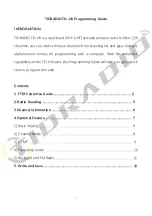
17
8.5.2 Accessory Cables
The image and table below show the wires of the transceiver and the connections
to optional devices such as an external GPS antenna and a GPS chart plotter.
CAUTION
Care must be taken not to touch any of the NMEA wires to positive
12 VDC or the radio may be damaged.
When connecting the Chart Plotter, External GPS receiver, or External Speaker
strip off about 1 inch (2.5 cm) of the specified wire’s insulation, then splice the
ends together.
The GX1400 series uses NMEA 0183/-HS protocol to share coordinates and
DSC information to and from a GPS chart plotter.
Wire Color/Description
Connection Examples
Yellow: NMEA GPS Input (+)
NMEA (+) output of GPS
Green: NMEA GPS Input (−)*
1
NMEA (−) output or common ground of GPS
White: NMEA DSC Output (+)
NMEA (+) input of GPS
Brown: NMEA DSC Output (−)*
1
NMEA (−) input or common ground of GPS
NOTE
: *1:Some GPS chart plotters have a single wire for NMEA signal ground. In
such a case connect the NMEA input (–) to the GPS chart plotter's single NMEA signal
ground wire, and leave the NMEA output (–) open.
In case the assignment of power supply and ground of a GPS chart plotter to be used is
different from that of the radio, connect the signal ground wire of the GPS chart plotter
to the ground terminal (GND) on the rear panel of the radio.
8.5.3 Connection to External GPS or Chart Plotter
GPS Chart Plotter
Plotter Connection
Radio Wires
NMEA OUT (
−
)
NMEA OUT (+)
NMEA IN (+)
NMEA IN (
−
)
White: NMEA OUT (+)
Brown: NMEA OUT (
−
)
Yellow: NMEA IN (+)*
2
Green: NMEA IN (
−
)*
2
NOTE
: *2: To inputs the GPS coordinates from the external GPS device to the GX1400,
the NMEA GPS input (+) (yellow) and the NMEA GPS input (-) (green) wire may be
connected to the NMEA output of the external GPS antenna or GPS chart plotter.
To connect with external device at 38400 baud
To connect with external device at 38400 baud, the GX1400 series may be
setup to receive GPS coordinates, send DSC signal at 38400 baud. Refer to
section “18.9 NMEA 0183 IN/OUT” for details.
















































